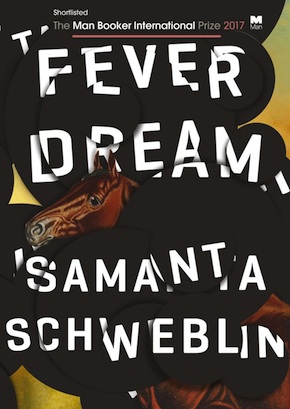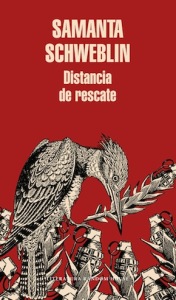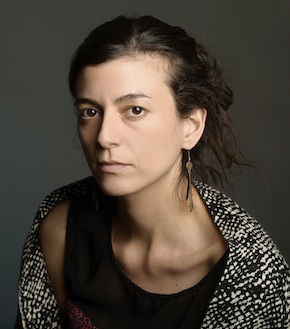Samanta Schweblin: Passion and terror
by Mark Reynolds
“Explosive… a skin-prickling masterclass in dread and suspense.” The Economist
Samanta Schweblin is an acclaimed Argentinian short-story writer whose compact debut novel Fever Dream is shortlisted for the 2017 Man Booker International Prize. A disorientating and utterly gripping psychological thriller and an unsettling exploration of family ties, panic and dread, it is told in spare dialogue between a woman called Amanda who lies dying in a dimly lit hospital ward far from home, and a boy called David at her side who is uncannily wise and urgently impatient. It’s a timeless fable of migrating souls and supernatural menace, set against the present-day backdrop of environmental breakdown and poisonous crop-spraying in Argentina’s sprawling soya fields.
I read Fever Dream in a single sitting on a train ride to Cornwall, once an extensively industrial area dominated by metal mines, quarries and their effluents, but now one of England’s most celebrated areas of natural beauty. I ask Schweblin if she has any hopes for a similar recovery in the Argentinian countryside where intensive agriculture has taken hold.
“Maybe,” she shrugs, “but only hundreds of years in the future because most of the farming is soya, which takes all the nutrients from the soil and gives nothing back. And these fields are so, so, so big. In Europe you can see where the landscapes end, but in Argentina – and in America – if you stand in the middle of these fields, it’s like being in the middle of the ocean.”
It’s no surprise all this is run by American-owned agrochemical companies like Monsanto, who modus operandi is to supply farmers with GM seeds that will only grow in certain chemical compounds – which they also supply.
“If you’re a small farmer and you want to work with your own seeds, you can’t,” Schweblin adds, “because Monsanto and other companies have registered the genetic codes of their seeds, and maintain that only these tested seeds are legal. Seeds that are natural, that a family may have been working with for thousands of years, they say have not been tested so they can’t be used. This is very dangerous, because we are losing hundreds of species of seeds, we are losing food.”
Her passion for environmental concerns is evident, but Fever Dream was constructed from many diverse elements, and it took Scwheblin longer than she expected to align them.
“At the beginning it was a short story, and I wrote it twelve times,” she recalls. “It was so strange, so frustrating, because I knew each of the characters, I knew the story almost completely, I knew about agrochemicals, the migrations and superstitions, everything – and it just didn’t work. It took me almost a year to realise I would need a hundred more pages than the ten I was accustomed to writing.
I love that feeling when you are thinking about a place, a conversation or an experience you know well, but you’re looking for something new… If you go back and pay more attention, there are so many more things to be discovered.”
“It needed that extra length because this book is kind of a psychoanalytical session: one person is lying on a bed while another person is sitting at the foot of it asking questions. You know that Amanda and David have gone over many of the things you are reading four or five times before. This is common in psychoanalysis – and in Argentina everyone, if you so much as break your hand, will go to the psychoanalyst. But I love that feeling when you are thinking about a place, a conversation or an experience you know well, but you’re looking for something new. It’s such an interesting exercise. If you go back and pay more attention, there are so many more things to be discovered.”
 The original title, Distancia de rescate (Rescue Distance), reflects a recurring preoccupation of Amanda’s about the enforced watchfulness of parenthood. “I was worried – I’m still worried – about this tie that binds us to the people that we love the most, and how dangerous this tie can sometimes be,” says Schweblin. “It’s like a fishing line that is transparent and seems harmless, but it’s something you can strangle a person with.” Entering the last years of her 30s, she wanted to explore her own fears of motherhood. “It’s like a last chance for me,” she says, “but I think motherhood is something that can hurt you constantly. You could spend the whole day imagining the worst possible scenario, and I think maybe I would be that kind of mother. My relationship with literature, when I read and when I write, is almost the same. I like to test myself in a situation that terrifies me the most.”
The original title, Distancia de rescate (Rescue Distance), reflects a recurring preoccupation of Amanda’s about the enforced watchfulness of parenthood. “I was worried – I’m still worried – about this tie that binds us to the people that we love the most, and how dangerous this tie can sometimes be,” says Schweblin. “It’s like a fishing line that is transparent and seems harmless, but it’s something you can strangle a person with.” Entering the last years of her 30s, she wanted to explore her own fears of motherhood. “It’s like a last chance for me,” she says, “but I think motherhood is something that can hurt you constantly. You could spend the whole day imagining the worst possible scenario, and I think maybe I would be that kind of mother. My relationship with literature, when I read and when I write, is almost the same. I like to test myself in a situation that terrifies me the most.”
She makes an analogy with her paternal grandfather, who was a guerilla fighter with the French Maquis in the Second World War: “He was really young, only seventeen or so, and his job was to take his bicycle in the middle of the night, leave his battalion, go as close as he can to the enemy and listen in on their plans for the next day. It was a very dangerous situation: in the dark, alone, so close to the enemy, but this information could save the lives of the whole battalion, so it was really important. I feel that literature can also give us the opportunity for this kind of dangerous mission – and to come back alive. By facing your worst fears you test yourself, you learn something, and when you come back you’ve felt the pain but you don’t have any wounds.”
Schweblin became wrapped up in Argentina’s widespread network of writing workshops from an early age, after her mother encouraged her to apply for one at the age of 16. “In Argentina it’s really common to go to a writer’s house to learn how to write,” she explains. “They are groups of maybe seven to ten people who write at home and bring in work for the whole group to read and comment on. It’s a very nice and authentic way of being close to literature, without being theoretical. It’s more like a writing kitchen, where you’re working with your hands.
“The first workshop was not so great, but still it was a big thing for me because it was the first thing I had done by myself as a young adult: taking the train an hour and a half into the inner city, then after the workshop I’d spend a couple of hours going around buying books. I was starting to build my own space in Buenos Aires for the first time.”
Her curiosity and enthusiasm for literature were fired by her family. “I was always fascinated by the passion some books can awaken in people. When I was really young I remember my grandfather reading some Latin American poetry, and he was reading aloud standing up and he was crying. Something really intense was happening, and I was outside that. I wanted to be in there.”
Later she attended the acclaimed workshops of Liliana Heker, in the company of published writers including Pablo Ramos, Guillermo Martínez, Inés Garland. She continued in those workshops for four years, honing her craft, getting her stories seen by an ever-widening circle of publishing professionals, publishing individual stories, and securing a powerful agent in the shape of Glòria Gutiérrez at Barcelona’s Balcells agency. Her first story collection El núcleo del disturbio (The Core of the Disturbance) was published in 2002 by Planeta.
Today Schweblin is leading her own workshops in Berlin, where she has been based since arriving five years ago for a one-year writing residency. “In the middle of that first year the Instituto Cervantes invited me to give some workshops,” she says, “and it worked so well. A lot of people were there, very interesting people, and when the course finished some of them asked me to continue so I invited them to come to my home, as we do in Argentina. I have two different groups and at around 7 in the evening they ring my bell and we have coffee and tea and they bring something to eat and we work for four hours until 11.” In the group are writers from all over the Spanish-speaking world who have settled in Germany, “so the Spanish is not only our language it’s also our personality. It’s fascinating to see the ways in which Mexican Spanish is different from Argentinian, and so on.”
Fever Dream is translated by Megan McDowell, and Schweblin is appreciative of her great care and understanding on every level. “It was a really nice experience working with her,” she says. “Some translators can be so obsessed and so perfectionist they ask you for a map of the house where your characters live, while at the other end you have translators and publishers in China or Italy who just send you the book when it’s printed – ‘Here, it’s done!’ – and you feel so insecure about what might be inside. Megan is just in the middle – in a good way. She has a lot of questions, she’s really serious, you can see that she’s thinking carefully not only about each word but also the complete form of the book.”
I’m grateful for each translation, which allows me to be read by so many people, even though at the same time you know something is lost in the process.”
Again, Schweblin has a delightful analogy that draws on family memories. “My grandfather on my mum’s side was an engraver,” she says, “and he had a big, big workshop in the middle of the city where he also taught young artists. From when I was five or six, I’d help him with the paper and the zinc plates. The technique is very interesting but also a little sad, because you make your original work on the zinc plate, which is the most beautiful piece of the whole process, but that’s not what people who want to buy art have in their living rooms; what they bring home is the printed paper, and each paper is different. By the end of the year this book will be translated into more than 25 languages, which is great, but it also means there are fewer people reading me in my own language; most of them are reading from this printed paper that is not the original. But, as George Steiner said, ‘Without translation we’d be living in small provinces bordering on silence.’ So I’m grateful for each translation, which allows me to be read by so many people, even though at the same time you know something is lost in the process.”
McDowell is now working on a selection of Schweblin’s early stories for publication in English in 2019, which will include the story ‘To Kill a Dog*’ a version of which I read and published as an editor at The Drawbridge back in 2009 (and has since appeared online in The White Review). It’s a disturbing story of initiation into extreme violence, centring on the act suggested in the title, which has proved a persuasive calling card in many countries. Written when she was just 18, and her first story to be published, it came to her in a flash.
“Usually you have to work a lot around an idea until you get the story,” she recalls, “but with this story something amazing happened. I sat down at night with the desire to write something new, and five hours later the story was done. It came from nowhere. I think animals are a kind of mirror for us. If you kill a person, you have to confront their terror, but if you kill an animal you have to confront your own terror, and I felt this was something interesting to investigate.”
Schweblin has recently been reading the other books on the Man Booker International Prize shortlist. She’s a fan of many of the other authors’ earlier works, and Fever Dream was partly influenced by David Grossman’s To the End of the Land. “He has a scene where two people are talking in a big, dark room. They can’t see one another, so the voices overlap, and when I started to work on Fever Dream, something about the ambience I felt when reading that scene seeped in.”
She was amazed and delighted to make the shortlist. “It’s such huge and unexpected recognition for the book,” she says, “my first novel and my first book to be translated into English, alongside all these great writers I have read with admiration. I’m aware that so many talented authors and great books don’t make the shortlist each year, so I also feel really lucky.”
I studied cinema for five years, and as soon as I finished I ran to my house and started writing stories.”
Schweblin studied cinema and screenwriting at university, and found it a perfect grounding for fiction writing. “I remember spending entire nights working on editing,” she says, “thinking, for example, what happens if we take this scene away, or what if we change the length of that one by just five seconds? These decisions are so related to writing fiction. I studied cinema for five years, and as soon as I finished I ran to my house and started writing stories, so it was clear to me that my career was about literature, not cinema.”
Nevertheless she is now working on a screenplay for Fever Dream, together with director Claudia Llosa. “Yes, and it’s a good process,” she says. “At the beginning I was wary, because I’m so controlling when I write, but of course it depends who you’re working with. When I realised how much better the film would become in Claudia’s hands, it was easier to let her in. I was also worried that maybe starting a screenplay might put my literary projects on hold, but it was completely the opposite. There have been periods of time – a week maybe – when I’ve had to put literature aside, but then there are weeks that are more calm, and it’s so nice to start the day writing the screenplay and end the day writing fiction. In a screenplay you’re thinking more in a logistical way – how do things happen, what is the important thing? – and when you write it, everything flows quickly. Then when I sit at night to write my fiction I think, ‘I’ve already done a lot today’, so I feel calm and I can spend two hours working on just one paragraph without the sensation that I’m losing time and have to hurry. So it’s been like therapy, and I enjoy the interplay between the two.”
In those nighttime writing sessions she’s begun a second novel, but it doesn’t always take precedence. “I’m working on short stories all the time,” she says. “I can’t avoid it, it’s my nature. It’s like if I wrote a novel, it’s because I failed at writing a short story – something went wrong!”
* now published as ‘The Test’ in the collection Mouthful of Birds (Oneworld, February 2019)
 Samanta Schweblin was born in Buenos Aires in 1978 and now lives in Berlin. She is the author of three story collections that have won numerous awards, including the prestigious Juan Rulfo Story Prize, and been translated into 20 languages. Fever Dream, translated by Megan McDowell, is published by Riverhead in the US and Oneworld in the UK. Read more.
Samanta Schweblin was born in Buenos Aires in 1978 and now lives in Berlin. She is the author of three story collections that have won numerous awards, including the prestigious Juan Rulfo Story Prize, and been translated into 20 languages. Fever Dream, translated by Megan McDowell, is published by Riverhead in the US and Oneworld in the UK. Read more.
Facebook: Samanta Schweblin
@sschweblin
Author portrait © Alejandra Lopez
Megan McDowell has translated contemporary authors from Latin America and Spain including Alejandro Zambra, Mariana Enriquez, Gonzalo Torné, Lina Meruane, Diego Zuñiga and Carlos Fonseca. Her translations have been published in The New Yorker, Tin House, The Paris Review, Harper’s, McSweeney’s, Words Without Borders and Vice, among others. She is based in Santiago, Chile.
meganmcdowelltranslation.com
Mark Reynolds is a freelance editor and writer and a founding editor of Bookanista.
@bookanista


